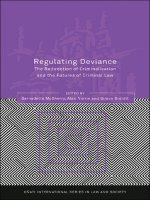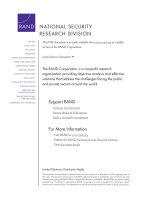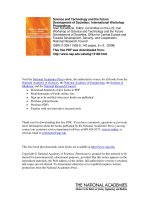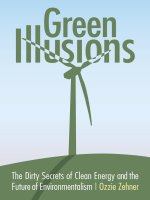SUSTAINABLE DEVELOPMENT AND THE FUTURE
Bạn đang xem bản rút gọn của tài liệu. Xem và tải ngay bản đầy đủ của tài liệu tại đây (178.09 KB, 25 trang )
SUSTAINABLE DEVELOPMENT AND THE FUTURE
After studying this chapter, you should be able to:
1. Explain why the balance of nature was altered only recently
2. Relate how humans were able to control nature
3. Enumerate the consequences of controlling nature
4. Comprehend the pressure on the environment, resulting from rapid increase population
5. Understand the problem of uneven distribution of wealth
6. Distinguish the problem of solutions offered to problem impacts in the world.
5.1. THE GLOBAL ENVIRONMENTAL SITUATION
Scientists have estimated that the Earth is more than four billion years old, and it will continue to exist for
around the same period of time. Life on Earth as we know it today came into being around three billion
years ago. Based on fossils found around the world, human beings have inhabited the Earth for more than
two million years. All this time, nature and life on Earth lived in equilibrium. There was no major
disturbance which could alter the balance of nature. This was true up to around 2000 years ago.
At around that time, people began to disturb the environment in such a manner as to effect the global
environment.
The rampant and reckless cuttings of trees in virgin forests have resulted in soil erosion, flooding,
expansion of deserts, and destruction of lakes. Overexploitation of other natural resources, like fish and
other aquatic resources, has resulted in alarming decrease of catch worldwide.
Too much use of fossil fuels, like oil and other minerals, has depleted these natural resources to much an
extent that the supply may not last for another one hundred years. It takes millions of years to form oil
from the fossils of plants.
The industrial revolution has produced all kinds of hazardous materials that harmed the environment-
pollution of the air, water, land, and the atmosphere. Many of these hazardous substances are also toxic to
humans as well as to other animals.
To be fair to those concerned, all these were the unwanted effects of a desire to improve the quality of life
- a very noble intention. In fact, as direct consequences of scientific breakthroughs in many fields of
human endeavor, people have in many ways succeeded in this worthy ambition. People were, to a certain
extent, able to control nature. By applying what they have discovered about the laws of nature, they were
able to conquer darkness though electric bulbs and fluorescent lamps, hot weather conditions through
electric fans and air conditioners, and cold weather through heaters. Through modern medicines and
sanitation, they were able to control the spread of diseases; through modern agriculture, they were able to
produce more food containing better nutrients.
The overall result of better living conditions, better sanitation, and better nutrition includes rise in life
expectancy and low infant mortality. The net effect is rapid increase in population.
Insightfulness
The luxurious life-style of the rich and famous contributes to environmental degradation.
According to the United Nations Statistical Yearbook (1988), the doubling of the population between
1950 and 1986 was accompanied by grain consumption of 2.6 times, energy use of 3.7 fold, and
quadruple economic output and sevenfold increase in the production of manufactured goods. All these
were accompanied by more than ninefold increase in water, air, and land pollution.
Insightfulness
Most developed countries have zero or very, very low population growth rate.
But the irony is, situation differ from region to region and country to country. Because of the wide gap
between the rich and the poor nations, the benefits of these increases do not apply equally among people
of the world.
For instance, despite overall rise in food production in the world, nearly a billion people (1/5 of the
world’s population) do not consume enough calories for an active working life. And because of less
scientific agricultural practices combined with a high population growth, the grain production per person
is declining in Africa, India, and Latin America.
In the less-developed countries, it is estimated that only half of the people have access to safe drinking
water. Because of this, around 10 million people worldwide die due to water-borne diseases. In the
industrialized countries, agriculture and industry are rapidly using up groundwater. Deforestation in many
areas aggravates the situation. It prevents the staring of groundwater.
The main sources of energy in the world are fossil fuels (oil and charcoal) and natural gas. At the
beginning of their use, many people thought that the supply is practically inexhaustible. But since Would
War II, energy consumption has increased more than four times. Scientists have since then changed their
predictions. They now predict that oil reserves will be used up in less than 50 years, and natural gas by
around 60 years.
Since the introduction of polluting materials by humans, the quality of air, soil, and water has deteriorated.
Humans, animals, and plants have been affected. Toxic pollutants cause many kinds of illnesses in
humans and animals. Oxides of nitrogen and sulfur, the ozone, and other pollutants are causing acid rain
that lower crop yield and damage millions of hectares of forests, especially among the industrialized
countries. Increase in atmospheric carbon dioxide is casing the so-called greenhouse effect. This is
predicted to alter the earth’s climate and raise ocean levels, with disastrous consequences to coastal towns
and cities.
Most of the time, nature is friendly. It seldom shows its fury. When it does, it is uncontrollable.
2
2
Table 5.1: Global problem impacts and problem causes
Problem Impacts
Problem causes
Unsustain-
able
population
growth
Poverty
and
Inequality
Unsustain-
able food
production
Unsustain-
able
energy use
Unsustain-
able
industrial
production
Unmet basic human needs for safe water, food,
shelter, health care, education, employment, etc.
■ ■ ☼ ► ►
Species depletion (extinction of plants and
animals, habitat degradation)
■ ■ ♣ ☼ ☼
Land degradation: soil erosion, desertification, loss
of fertility
■ ♣ ■ ♣ ►
Depletion of nonrenewable energy and minerals ♣ ► ♣ ■ ♣
Depletion of fresh water (groundwater and surface
water)
♣ ► ■ ► ♣
Water pollution: chemical and bacterial
contamination of groundwater and surface water
♣ ☼ ♣ ☼ ■
Air pollution: urban air pollution, acid deposition, ♣ ☼ ☼ ■ ■
3
3
ozone layer depletion, greenhouse gas buildup
Conflict and war: domestic and international ♣ ♣ ☼ ☼ ☼
Source: W. Lorson, ed., The Global Ecology handbook, 1990
■: Very important cause ♣: Moderately important cause
☼: Less important but insignificant cause ►: Unimportant or insignificant cause
4
4
It can be seen from above table that unsustainable population growth is a very important cause of
three problem impacts and a moderately important cause for the five other problem impacts.
It is very difficult to meet the basic human needs for food, safe water, shelter, health care,
education, and others by too rapid increase in population without straining the environment. And an
unrestrained exploitation of our natural resource results in the loss of virgin forests and soil
fertility, soil erosion of deserts. These in turn deprive many animals and plants of their natural
habitat. Extinction of many animal and plant species is a direct consequence.
In order to support an ever - increasing population, more and more factories must be put up.
Industry must be expanded and of course pollution follows, the consequences of which are already
enumerated above.
The probability of conflict between ethnic groups and nations is increased with unsustainable
population growth. They may fight over needs resources, like oil and water. Or, they may fight for
territories needed by their increasing number. The resulting misery and human sufferings brought
about by war are too well known.
The possibility of poverty and unequal distribution of wealth becomes greater with unsustained
population growth. Food production may not be able to keep up with the increase in the number of
consumers.
Geographically, the earth is divided into nations with varying resources and with varying
population densities and varying degrees of industrialization. In short, some countries are wealthier
than others. And even in the same country, the structure of society varies; there is a very wide gap
between the rich and the poor. Cutting more trees and over fishing in order to survive are likely
examples of this.
Guide questions
1. Explain the main reasons why humans drastically alter the global environment.
2. Explain some of the consequences of altering the balance of nature.
3. Enumerate more beneficial effects of humankind’s being able to control nature.
4. Why is the increase in food consumption, energy use, and economic output much greater
than the increase in population?
5. Cite policies by some governments around the world to address the problem of inequality of
life among peoples of the world.
5.2. SUISTAINABLE DEVELOPMENT
The past 20 years have seen a growing realisation that the current model of development is
unsustainable. In other words we are living beyond our means. From the loss of biodiversity with
the felling of rainforests or over fishing to the negative effect our consumption patterns are having
on the environment and the climate. Our way of life is placing an increasing burden on the planet -
this cannot be sustained.
5
5
The increasing stress we put on resources and environmental systems such as water, land and air
cannot go on for ever. Especially as the world's population continues to increase and we already see
a world where over a billion people live on less than a dollar a day, more than 800 million are
malnourished, and over two and a half billion lack access to adequate sanitation.
Some people started realizing the development and environmental protection are inequality; such
as:
- Successful economic development and environmental protection go hand in You cannot have
one without the other (Former U. S President George Bush)
- Achieving sustainable economic growth will require the remodeling of agriculture, energy
use, and industrial production after nature’s example (JessicaTuckma Mathews, World
Resource Institute)
- Our global future depends upon sustainable development. It depends upon our willingness
and ability to duplicate our intelligence, ingenuity, and adaptability - and our energy - to
our common future. This is a choice we can make (the Report of the world commission on
environment and development)
Some countries are more developed than others in terms of agriculture, industry, education, health
services, and other aspects of development. Most of the countries in Western Europe are more
developed than those of Eastern Europe. Similarly, the countries in North America are more
developed than those of Central and South America. Likewise most countries in Africa are less
developed. Some countries in Asia like Japan, Korea, Taiwan, and Singapore are more developed
than others like the Philippines, Malaysia, Indonesia, Bangladesh, India and Vietnam.
The People’s standard of living also varies from one country to another. Needless to say, those
from the developed countries, on the average, have higher standard of living.
Some researches show that the less developed countries, as measured by their per capita income,
have higher birth rates, lower life expectancy, poorer dwellings, lower birth weights, lower literacy,
less number of doctor and nurses per unit population, and consume less energy and fewer calories.
A widely-used and accepted international definition of sustainable development is “development
which meets the needs of the present without compromising the ability of future generations to
meet their own needs”. This means development without permanent damage to the ecological
system.
Sustainable development means using the natural resources only to a certain extent so that they will
be able to recover. It further means that population should either be help to a minimum or be
stopped altogether. This is the same as saying that sustainable development must not endanger the
atmosphere, water, soil, and ecosystem that support life on earth. Moreover, sustainable
development requires societies to meet human needs by increasing productive potential and by
ensuing equitable economic, social, and political opportunities for all.
6
6









